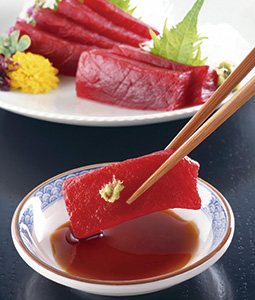INDEX

White wasabi flowers bloom in spring 

Grated wasabi root (top) to accompany sashimi (bottom)
- PREVIOUS
- NEXT
May 2021
Wasabi Cultivated in Clear-flowing Water

Wasabi (Wasabi japonica) is a native Japanese plant and an essential condiment in Japanese cuisine. Shizuoka Prefecture’s traditional wasabi cultivation method using spring water has been designated as a Globally Important Agricultural Heritage System.

Wasabi is an essential condiment in Japanese cuisine such as sushi, sashimi, soba noodles and ochazuke tea on rice. Originally harvested from the wild in various mountainous regions of Japan, the rhizome (root) of wasabi is grated as an accompaniment to dishes and is known for a sharp and fresh pungency that travels through the nose.
The cultivation of wasabi is considered to date back some 400 years, when people found wild wasabi growing in the valley of the 1,504-meter-high Mt. Bukkoku (popularly known as Wasabi Mountain) overlooking the Utogi area of present-day Shizuoka City in Shizuoka Prefecture, then brought it back to their villages and planted it near a spring water source.
According to the Shizuoka Prefectural Government, cool and nutrient-rich spring water is important for traditional wasabi cultivation, which rarely uses fertilizer or agricultural chemicals. Shizuoka Prefecture’s high rainfall, geological features, and an abundant year-round supply of spring water with a temperature of around 13 degrees Celsius—ideal for wasabi cultivation—make it a leading wasabi cultivation region.

A unique cultivation method called “tatami-ishi wasabi field” was established when wasabi cultivation spread to the Izu peninsula, which lies to the southeast of the Utogi area.
Tatami-ishi (tatami-mat rock) style wasabi fields are terraced fields with large rocks in the bottom layer and rocks of gradually reducing sizes in the upper layers finishing with sand at the top.* A flow of copious spring water through the fields filters out impurities, keeps the water temperature stable, and supplies the nutrients and oxygen wasabi needs to grow. This has enabled stable wasabi production in various parts of the prefecture.
In 2018, the wasabi fields in Shizuoka Prefecture were designated as a Globally Important Agricultural Heritage System by the Food and Agriculture Organization of the United Nations (FAO) in recognition of the conservation of their surrounding natural environment and traditional cultivation method.


The smaller the year-round difference in temperature, the faster the growth and the higher the yield of wasabi. For this reason, in areas where there is a need to control changes in water temperature due to sunlight, large numbers of deciduous Japanese alder trees are planted to create shade.
The clear water flowing down the wasabi fields and the green carpet of wasabi leaves at the water’s surface make for a truly refreshing sight.
We asked the prefectural government’s official in charge of promoting Shizuoka’s wasabi cultivation for their recommended ways to enjoy wasabi.
“I would say that it’s best enjoyed in sushi, but I also recommend savoring the flavor of the wasabi itself. A great way to do this is to try wasabi-meshi, which is steamed white rice topped with grated wasabi root, katsuobushi (dried bonito flakes), and soy sauce. Wasabi is available in tubes, but I would like more people at home to enjoy the taste of wasabi grated from the root. This traditional method of cultivation has been recognized as a Globally Important Agricultural Heritage System, and we will work together as a community to conserve it for the generations to come and protect our beautiful landscape.”
* https://shizuoka-wasabi.jp/en/about/
- PREVIOUS
- NEXT

